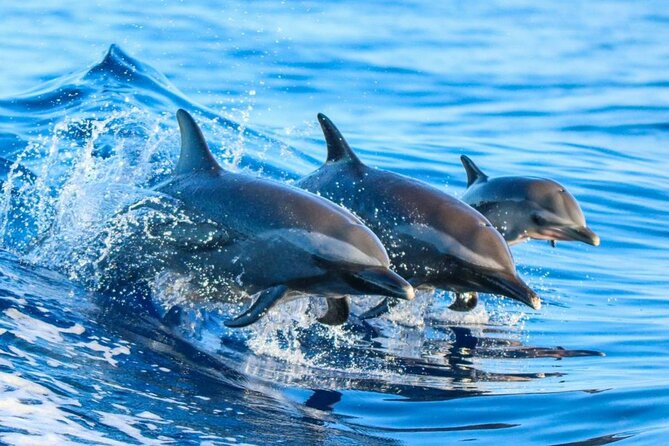Dolphins are immensely fascinating beings, in Zanzibar you can encounter them closely, watch, swim or snorkel, tours below
- Transportation
- Boat fees
- Snacks
- Snorkel gears
MORE TO DO in Zanzibar
Mnemba island dolphin trips
Mnemba island is known for it’s well-preserved coral reef :- Here you can swim with the dolphins,do snorkeling before going to the sandbank near the Mnemba Island where you can enjoy the white sand beach and fruits.
Kizimkazi dolphin trips
Kizimkazi is located extreme Southern Coast of Zanzibar, this sleepy fishermen village is the best place to spot and swim with the dolphins. Infact At Kizimkazi, Dolphins live just few meters from the beach.
Zanzibar dolphin tour (Know before you go)
The best month to swim/see Zanzibar dolphins is June, July, August, September, October. Also, January to early march. Time very early morning (5-8am)
There are common 3 types of dolphins in Zanzibar
- Spinner dolphins (Stenella longirostris)
- Indo-Pacific Bottlenose Dolphins (Tursiops aduncus)
- Rizzo’s Dolphins (Grampus griseus)
Zanzibar dolphins: are not caged, they live freely at their natural enviroment. A very early morning trip is required After 8:00 AM dolphins returning to their hideouts deep in the ocean.
Dolphins Are Carnivores
-Dolphins eat a wide variety of foods, including fish, squid, octopus, crustaceans, cephalopods, and other marine life. Smaller dolphins usually stick to a diet of fish and other small prey. Larger dolphins, such as the killer whale (bet you didn’t know that a killer whale is actually a dolphin!) eat larger things, like sea lions, seabirds, sharks, and penguins.
Dolphins Only Sleep with Half of Their Brain
-Dolphins and whales sleep in an unusual way. Called “unihemispheric slow-wave sleep,” it basically means that they sleep with only half of their brain. When a dolphin goes to sleep, it shuts down one hemisphere of its brain and closes the opposite eye. This allows the dolphin to monitor what’s going on around them and to regulate breathing. While they are sleeping, some dolphins are motionless at the surface of the water. Other times, they might swim slowly. Over a 24-hour period, each side of a dolphins brain gets about 4 hours of sleep.
Dolphins Live a Long Time
-The life expectancy of dolphins vary, but the common bottlenose dolphin can live a whopping 20 to 50 years! To determine a dolphin’s age, veterinarians can count the rings inside each tooth. Each growth ring indicates one year of life.
Dolphins Do Not Have Hair
-Dolphins have a few sparse hair follicles but any hairs that are present fall out before or quickly after birth. They don’t have any sweat glands either. Their skin is usually gray to dark gray, smooth, and rubbery. The outer layer is the epidermis. The epidermis is extremely thick and constantly flakes and peels, just like humans. In fact, the epidermis of a dolphin is 10 to 20 times thicker than the epidermis of other mammals.
Their outer layer of skin is quickly sloughed off and replaced, keeping their body smooth and ensuring that they can swim efficiently.
A Group of Dolphins is Called a Pod
Dolphins live in social groups called pods. The number of dolphins in a pod varies, but can be a
They Are Highly Intelligent
Scientists that study dolphins believe that their intelligence rivals that of a human, or that they may be even smarter than us. By using a two-way mirror, they can perform experiments and study to see how they respond to them.
A Baby dolphin is called a calf, is born tail first. It’s the only known animal that isn’t born head first. The calf would drown before being birthed.
Dolphin can drown Despite living in and loving the water, it’s possible for a dolphin to drown. Just one tablespoon of water in a dolphin’s lung could cause the mammal to drown. It takes about two tablespoons for a human to drown.
Dolphins know what is around them based on sound. The mammals use their infamous “clicks,” which can travel long distances and bounces of other objects, to let the dolphin know how close the object is, its shape, movement, and texture.
It’s no surprise Dolphins can “see” with sounds as they have the best sonar in nature, even better than bats.
Dolphins may love fish, but they don’t use any of their 100 teeth to chew. Dolphins do not have the jaw muscles necessary for chewing, so the teeth are only used to catch fish. Then the dolphin swallows the fish whole.
Dolphin use tools: Over the course of evolution, hunters and gathers turned to tools to better be able to find food and perform work without having to use up all of their time and energy. At the same time as humans were evolving, dolphins were as well in their own way. Dolphins also use tools. They have been observed picking up sponges to protect their snouts while they forage for food at the bottom of the water. While scientists are still discovering all of the ways dolphins interact with tools, it’s clear they use them for lots of different porpoises.

